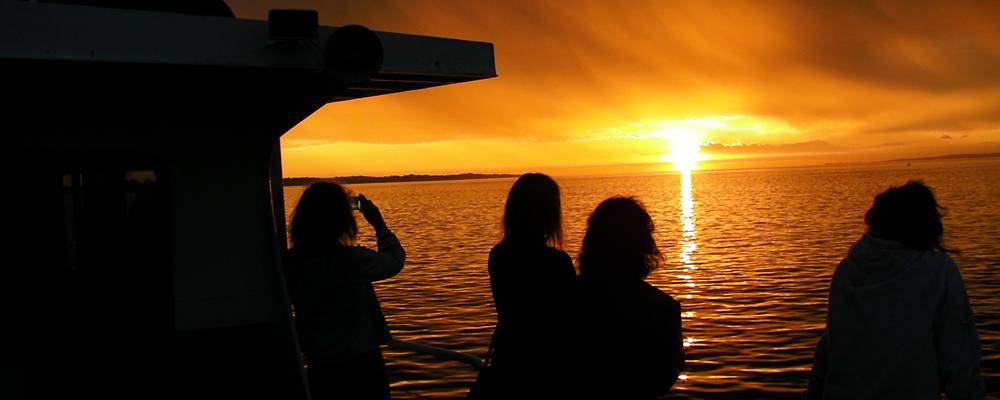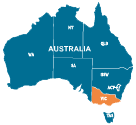Phillip Island Local Fishing Information
Catch of the day
 Fishing is an industry on the island and in the days before tourism, was the main industry along with chicory farming.
Fishing is an industry on the island and in the days before tourism, was the main industry along with chicory farming.
Today, you can see the shark boats of San Remo moored at the jetty unloading their catch after returning from weeks at sea. The Fishermen's Co-Op near the jetty sells fresh fish and also operates an extremely popular fish 'n' chip shop which is open 7 days a week.
For the rod and line fisherman there is good fishing from the jetties at San Remo, Newhaven, Rhyll, Cowes and Corinella.
For the surf fisherman the south side of the island from Forrest Caves to Cape Woolamai is worth a try but please be aware of the endangered 'Hooded Plover' (so called because of it's black head) which nests on the sand and feeds in the shallows along this stretch of coast.
Charter fishing boats may be booked from San Remo and hire boats are available from Rhyll and Corinella.
There is a great variety of fish to be caught in Western Port Bay, the most common being Flathead, Snapper, Whiting, King George Whiting, Flounder, Salmon, variety of Sharks, Garfish, Trevally etc The best bait, is the natural food of the fish, so if you can pump or buy fresh bait, do so, you won't be disappointed. Surf fishermen fillets of fish, especially oil based like Bonito (tough skin hard to get off the hook) make excellent bait.
Boat Ramps
Rhyll across from Westernport Rent-a Boat all tides.
Anderson Road Cowes West high tide.
Newhaven Beach Road high tide.
Corinella high tide.
Coronet Bay and Grantville also have boat ramps.
Tide Times
Tide times are usually available in all stockists of fishing gear and are also found in the local papers.
Bag Limits - Licences
Before fishing be aware of the bag and size limits of the various species also what licences if any are required.
Whiting:
![]() Both King George and Eastern School whiting are found throughout the coast.
Both King George and Eastern School whiting are found throughout the coast.
King George are caught both within the inlets and in deep water, (up to 20m) off shore. Light line is preferred; weight of tackle used for whiting depends on the depth of water being fished and the strength of the tidal stream.
Baits used include bass yabbies (nippers), pipis, cockles, mussels, worms, squid and small fillets of pilchard or other small fish. Squid is excellent for big whiting but should be cut into thin strips and pounded with a meat tenderiser to break up the fibres.
Snapper:
 Are taken both offshore and inside the inlets over a wide size range. Although heavy tackle is still used by some anglers, it is not necessary. However when using lines as light as 6kg it is recommended using a heavier leader of say 15kg breaking strain.
Are taken both offshore and inside the inlets over a wide size range. Although heavy tackle is still used by some anglers, it is not necessary. However when using lines as light as 6kg it is recommended using a heavier leader of say 15kg breaking strain.
Running sinker rigs are usually favoured for snapper when fishing in water shallower than 20 metres, and where the bottom is reasonably clean. Suitable sinker patterns are ball, bean, barrel and pyramid in weights from 25g to 150g depending on depth of water and strength of tidal stream.
A most effective leader for snapper fishing can be made from approximately 75cm of 15kg monofilament with solid brass ring or swivel tied to one end and a hook tied to the other. A second hook sliding on the line is an advantage and is placed in the bait as well giving increased hook cover. Size 4 hooks are preferred.
Flathead:
 The largest flathead inhabit the shallowest of water and the deeper waters and channels produce the smallest specimens or channel rats.
The largest flathead inhabit the shallowest of water and the deeper waters and channels produce the smallest specimens or channel rats.
In deep water, the most effective technique of flathead fishing is to allow the boat to drift with the wind or tide so that the sinker bumps along the bottom.
Whether drifting or fishing at anchor, the rig remains the same. The sinker, usually a bomb pattern, is tied to the end of the line. Its weight is dependent on the tidal stream and depth of water, with the hook on a short dropper at least half a metre above the sinker.
Flathead will take whitebait, pilchards and fillets cut from any fresh fish. Live mullet also make good flathead bait. Lures are also reasonably successful.
Garfish:
![]() Sea garfish are abundant in all South Gippsland tidal lagoons where they feed on algae and other vegetable organisms. However, they are more than happy in include sandworm, maggots, tiny slivers of fish and pipi flesh in their diet. Although usually taken on a small hook, certainly no bigger than a No. 4, fished under a float, the biggest specimens are often encountered while fishing on the bottom for whiting.
Sea garfish are abundant in all South Gippsland tidal lagoons where they feed on algae and other vegetable organisms. However, they are more than happy in include sandworm, maggots, tiny slivers of fish and pipi flesh in their diet. Although usually taken on a small hook, certainly no bigger than a No. 4, fished under a float, the biggest specimens are often encountered while fishing on the bottom for whiting.
Garfish respond well to berley and can be attracted by anchoring in shallow water and beginning a berley trail of bread, pollard, layer's pellets or bran.
The best areas for garfish seem to be quiet sheltered corners of inlets in less than 3m of water.
Silver Trevally:
Are common throughout South Gippsland. Larger specimens seem to be found offshore around the island groups, while juveniles are abundant in coastal inlets to the limit of tidal influence.
Silver Trevally will accept a wide variety of baits including whitebait, pieces of pilchard, all shellfish like pipis and mussels as well as bass yabbies and craytail.

Find accommodation on the Victorian Coast www.coastalstays.com:



